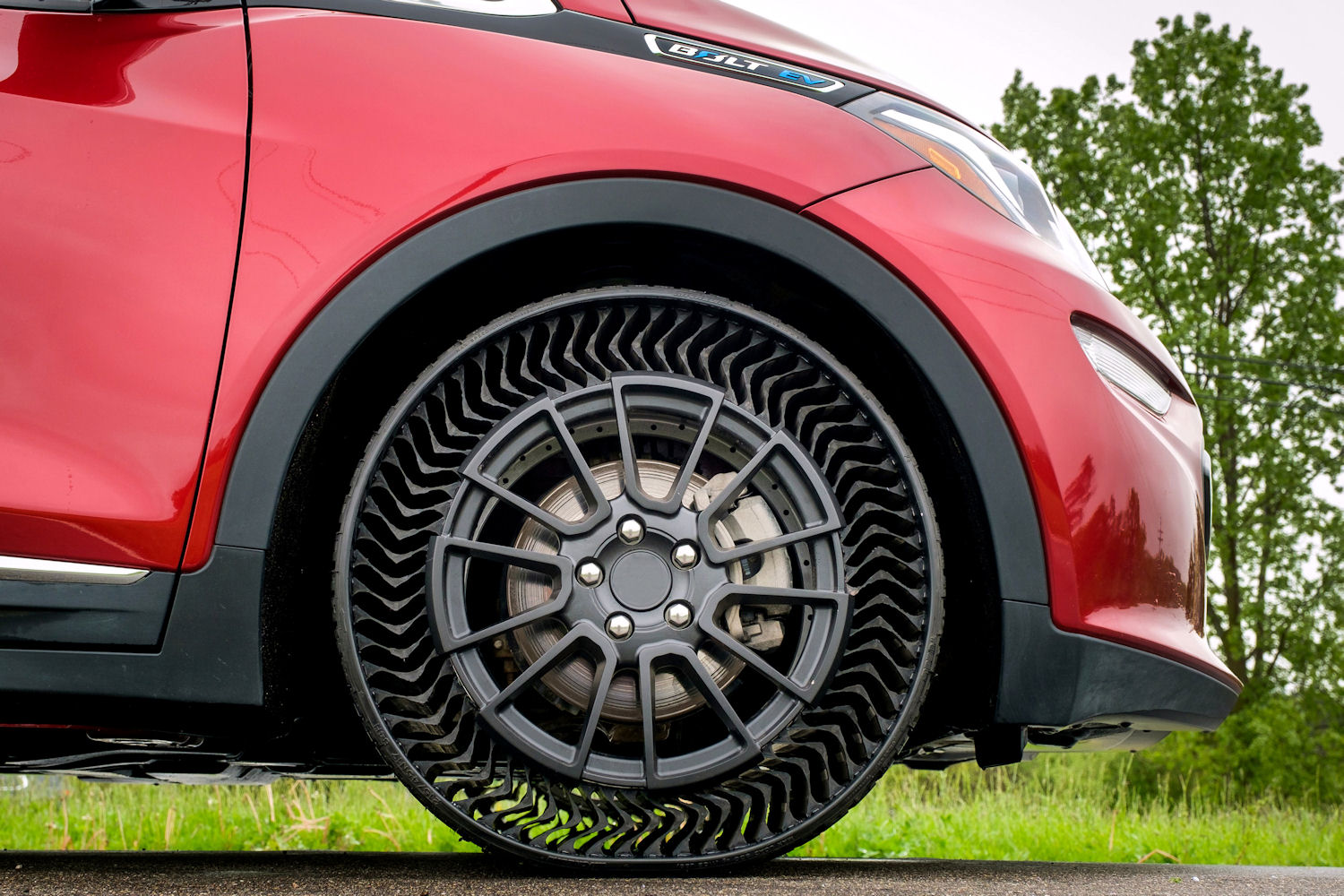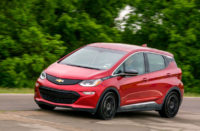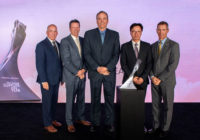No more flat tyres: Michelin presents airless solution for cars
 The Uptis Prototype’s descendants may be fitted to passenger cars by 2024 (Photo by Steve Fecht for General Motors)
The Uptis Prototype’s descendants may be fitted to passenger cars by 2024 (Photo by Steve Fecht for General Motors)
A new prototype wheel technology showcased at the Movin’On sustainable mobility summit this week promises to put an end to punctures, spare tyres (or that awful can of repair foam lurking in the bowels of your car’s boot) and regular tyre pressure checks. It’s called the Michelin Uptis Prototype – short for ‘Unique Punctureproof Tire System’. The tyre/rim combination builds upon the Michelin Tweel technology used in lawncare and industrial applications, and Michelin stresses it is more than merely a concept.
The tyre maker calls the Michelin Uptis Prototype “a new generation of airless wheel technology for passenger vehicles” and says cars may use the solution within the coming five years. Work towards bringing Uptis to public roads is being carried out under a joint research agreement between Michelin and General Motors. The two companies intend to validate the Uptis Prototype with the goal of introducing Uptis on passenger models as early as 2024.
Michelin and GM are currently testing the Uptis Prototype in the USA. Here it is being put through its paces fitted to a Chevrolet Bolt EV (Photo: Steve Fecht for GM)
Michelin and GM are currently testing the Uptis Prototype, beginning with vehicles such as the Chevrolet Bolt EV. Later this year, the companies will initiate real-world testing of Uptis on a test fleet of Bolt EV vehicles in the US state of Michigan.
Not only does an airless wheel assembly improve safety by eliminating flat tyres and punctures, Michelin says Uptis will improve fleet efficiency by minimising downtime and offering near-zero levels of maintenance. The tyre maker also expects the new product to deliver environmental benefits in the form of reduced raw material usage for replacement or spare tyre production. Michelin notes that approximately 200 million tyres worldwide are currently scrapped prematurely every year as a result of punctures, damage from road hazards or incorrect air pressure that causes uneven wear.
For Michelin, the Uptis Prototype represents a major advancement toward achieving its VISION concept, which was presented at the Movin’On Summit in 2017 as an illustration of the company’s strategy for research and development in sustainable mobility. The VISION concept introduced four main pillars of innovation: airless, connected, 3D-printed and 100 per cent sustainable (entirely renewable or bio-sourced materials).
“Uptis demonstrates that Michelin’s vision for a future of sustainable mobility is clearly an achievable dream. Through work with strategic partners like GM, who share our ambitions for transforming mobility, we can seize the future today,” states Florent Menegaux, chief executive officer for the Michelin Group.
“General Motors is excited about the possibilities that Uptis presents, and we are thrilled to collaborate with Michelin on this breakthrough technology,” adds Steve Kiefer, senior vice president, global purchasing and supply chain, General Motors. “Uptis is an ideal fit for propelling the automotive industry into the future and a great example of how our customers benefit when we collaborate and innovate with our supplier partners.
The Uptis Prototype is re-engineered for today’s passenger vehicles, and it is also well suited to emerging forms of mobility. The vehicles and fleets of tomorrow — whether autonomous, all-electric, shared service or other applications — will demand near-zero maintenance from the tyre to maximise their operating capabilities.
Uptis was co-unveiled at Movin’On by Eric Vinesse, executive vice president, research and development at Michelin. “The Uptis Prototype demonstrates Michelin’s capacity for innovation — in both the mastery of these high-tech materials, and also the development approach in close collaboration with GM, which validates our Vision concept as a roadmap for innovation,” says Vinesse. “Uptis represents progress toward Michelin’s vision for tomorrow’s mobility, and also embodies our commitment to a better, sustainable mobility for all.”
The prototype solution features ground-breaking improvements in architecture and composite materials, which enable Uptis to bear the car’s weight at road-going speeds. These innovations combine to eliminate compressed air to support the vehicle’s load.




Comments